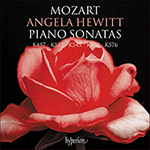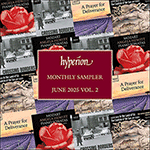
Welcome to Hyperion Records, an independent British classical label devoted to presenting high-quality recordings of music of all styles and from all periods from the twelfth century to the twenty-first.
Hyperion offers both CDs, and downloads in a number of formats. The site is also available in several languages.
Please use the dropdown buttons to set your preferred options, or use the checkbox to accept the defaults.

| Angela Hewitt (piano) NEW» More |
The theme (which in the English-speaking world is known as ‘Twinkle, twinkle, little star’) was published in Paris for the first time in 1761, though it is thought to have existed already for twenty years before that. Originally it was presumed that Mozart composed these variations in 1778, the year in which he spent nine miserable months in Paris. More recent research, however, dates them to 1781/2 because of the handwriting in two autograph fragments.
The first variations show off each hand in turn, first with semiquavers, then triplets. The minor mode is used for variation 8, but we return to major for the march-like variation 9. After some hand-crossing in variation 10, Mozart gives us an adagio as No 11 that shows how he can create magic out of nothing. It is like a scene out of one of his operas. Both hands get busy in the final variation 12, which changes the time signature from 2/4 to 3/4, bringing this charming piece to a brilliant finish.
from notes by Angela Hewitt © 2025
Le thème (que, dans le monde anglophone, on appelle «Twinkle, twinkle, little star») fut publié à Paris pour la première fois en 1761, mais l’on pense qu’il existait alors déjà depuis une vingtaine d’années. À l’origine, on a présumé que Mozart avait composé ces variations en 1778, l’année où il passa neuf mois d’infortune à Paris. Toutefois, des recherches plus récentes les datent de 1781/2 en raison de l’écriture dans deux fragments autographes.
Les premières variations mettent en valeur chaque main à tour de rôle, tout d’abord avec des doubles croches, puis des triolets. Le mode mineur est utilisé pour la variation 8, mais l’on passe au majeur pour la variation 9 dans le style d’une marche. Après quelques croisements de mains dans la variation 10, Mozart nous donne un adagio comme nº 11 qui montre comment il peut créer de la magie à partir de rien. C’est comme une scène sortie de l’un de ses opéras. Les deux mains s’activent dans la dernière variation, la nº 12, où le chiffrage des mesures passe de 2/4 à 3/4, amenant cette charmante pièce à une fin brillante.
En mai 1787, le père de Mozart mourut et c’est ainsi que se termina leur abondante correspondance. Leurs lettres sont une grande source d’information non seulement sur la vie quotidienne de Mozart, mais également sur ses compositions. Ensuite, même les lettres à sa sœur furent assez rares. On sait donc très peu de choses des origines des dernières sonates pour piano.
extrait des notes rédigées par Angela Hewitt © 2025
Français: Marie-Stella Pâris
Das Thema (das im deutschsprachigen Raum als Weihnachtslied „Morgen kommt der Weihnachtsmann“ bekannt ist) wurde 1761 in Paris zum ersten Mal veröffentlicht, obwohl es vermutlich schon zwanzig Jahre vorher existierte. Ursprünglich wurde angenommen, dass Mozart diese Variationen 1778 komponiert hatte—das Jahr, in dem er neun unglückliche Monate in Paris verbrachte. Neuere Forschungen datieren sie jedoch aufgrund der Handschrift in zwei autographen Fragmenten auf die Jahre 1781/2.
In den ersten Variationen kommen die Hände jeweils nacheinander zur Geltung, zuerst mit Sechzehntelnoten, dann Triolen. In der 8. Variation wechselt die Musik nach Moll, kehrt aber in der marschartigen 9. Variation nach Dur zurück. Nach einigen Handüberkreuzungen in Variation 10 wartet Mozart mit einem Adagio als Nr. 11 auf, in dem er sozusagen aus dem Nichts etwas Wunderschönes zaubert. Es ist wie eine Szene aus einer seiner Opern. Beide Hände sind in der abschließenden Variation 12 beschäftigt, wo die Taktvorzeichnung von 2/4 zu 3/4 wechselt, womit dieses charmante Stück zu einem brillanten Abschluss kommt.
aus dem Begleittext von Angela Hewitt © 2025
Deutsch: Viola Scheffel
 Mozart: Piano Sonatas K457, 533, 545, 570 & 576 Mozart: Piano Sonatas K457, 533, 545, 570 & 576With this, the third and final volume of Mozart’s complete piano sonatas, Angela Hewitt completes yet another of her memorable Hyperion series. Of earlier instalments, Gramophone admired the ‘spotless surfaces and impeccable proportions’ of ...» More |
 Hyperion sampler - June 2025 Vol. 2 Hyperion sampler - June 2025 Vol. 2 |

